Costa Rican food is healthy, comforting, and flavorful. If there is one cuisine that efficiently blends the three, it is definitely Costa Rican cuisine.
Traditional Costa Rican food comprises rice, seasonal vegetables, fresh fruits, choice meats, and various beans.
Thanks to its thriving environment and hardworking farmers, Costa Rican dishes are always full of freshness, bursting with natural flavors yet oozing with simplicity.
Costa Rican cuisine is never in excess, especially in spices – except for garlic.
It is widely considered mild but delightfully colorful, enticing you with the prevalent mix and match of white, brown, red, and green colors.
Several Costa Rican dishes that are popular in the country can be found in this article.
This includes the authentic Casado, a plate of several types of food that features meat, rice, some salad, plantains, and beans.
It is considered a traditional lunch or dinner meal.
Typical Costa Rican food can leave you feeling full, yet it’s time to eat again. It’s because the meals are basically packed with high levels of protein and carbohydrates.
Meat is almost always in every viand, for breakfast, lunch, or dinner. The rice ad beans combination, too, is a primary culprit in making you feel stuffed for hours.
Even its most famous dessert is also made of rice!
Because popular foods in Costa Rica end up having meat in them, you might wonder if there is any chance that a vegetarian will come to appreciate the flavors of Costa Rica food.
The answer is yes: many (if not all) restaurants have vegetarian plates to offer you, and authentic kid-friendly Costa Rican food is also available.
Check out our detailed Costa Rica Travel Guide to plan your vacation.

1. Gallo Pinto
Recommended by Jorge & Cláudia from Travel Drafts
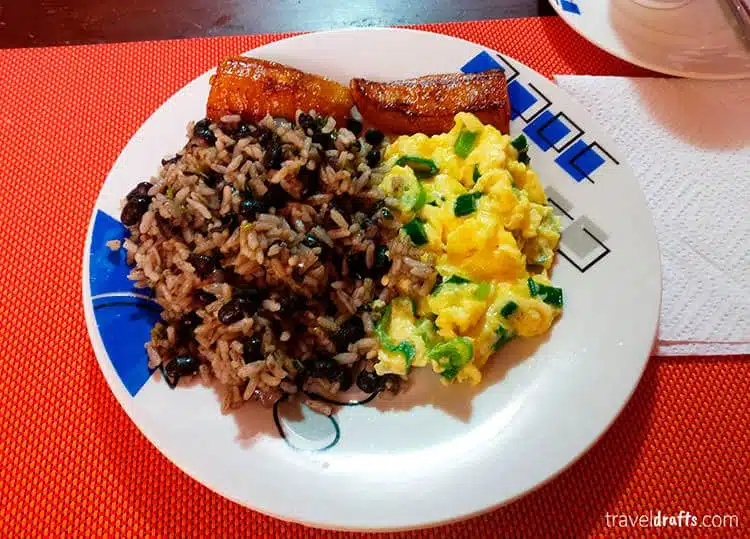
Gallo Pinto is the staple dish of Costa Rica, and it is made with rice and black beans mixed and fried with cilantro and onions.
It is frequently served with fried eggs, plantain, bacon, avocado, corn tortilla, and sour cream.
This traditional dish is commonly a breakfast dish, but eating it at any time of the day is perfectly normal.
Gallo Pinto is also a traditional dish in the rest of Central America. It used to be done by the Mestizo’s, which combined the beans used by the indigenous people, and the rice introduced by the Spaniards. At the same time, enslaved Africans influenced the way it was cooked.
You can say that this dish is a mixture of influences from the world’s different continents.
Be aware that Galo Pinto has several variations, depending on the region of Costa Rica. The beans and rice are cooked on the Caribbean coast with coconut milk.
In Guanacaste, Gallo Pinto is made with red beans. And in Valle Central, it is more moist and seasoned with chili.
It is effortless to find places to eat Gallo Pinto, as it is a typical dish in every soda – the fast food or local restaurants where the locals eat cheap and traditional food.
There is also a big possibility that your lodge will serve Gallo Pinto for breakfast.
2. Patacones
Recommended by Sam from My Flying Leap

Patacones, sometimes called tostones, are a traditional Latin American food you can find in most Central and South American countries.
It is made from mashed green plantains fried to a crisp outside and remains a little soft inside.
They are usually pressed into a circular shape several inches across though some places get creative and shape them into bowls or baskets.
Patacones come in any size, and the presentation often depends on what they are served with.
The patacones usually don’t have many flavors, so they serve as an excellent base food, similar to how rice is used in many countries. They can be eaten as appetizers with sides like guacamole, bean dip, and pico de gallo.
Or, they can be covered with ground beef, cheese, fish, vegetables, or beans. You may even see them with chimichurri or other dips and sauces. There’s really no limit to how they can be enjoyed.
Patacones are a staple food in many areas, and they are wonderful comfort food. Each country, and even regions within a country, will put its own spin on this dish.
If you’re looking for great typical Latin American fare in Costa Rica, definitely try the patacones.
3. Chifrijo
Recommended by Sarah from ASocialNomad
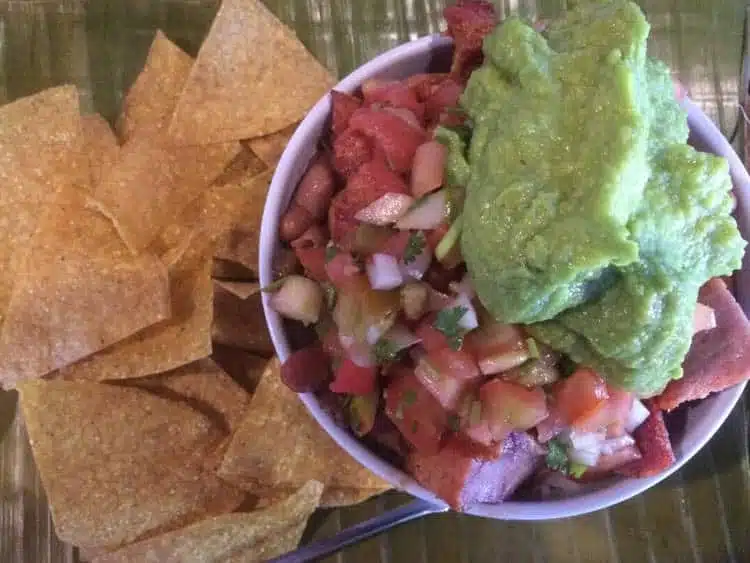
Making a list of what to eat is one of the key things on our Costa Rica travel checklist. Chifrijo was at the top of the list. And remains so.
Technically, Chifrijo in Costa Rica goes down as a salad-
You will, however, see Chifrijo usually on the menu as a bar snack or appetizer.
Chifrijo is a bowl of rice and beans (what else, you’re in Costa Rica), but then it’s topped with Chicharrones, which are double deep-fried pieces of pork rind, drizzled with lime juice and accompanied by fried yucca.
In England, we know this as twice-fried pork as pork crackling. Each gorgeously tempting bowl of Chifrijo is topped with avocado, Pico de Gallo, chimichurri, and lime.
Usually, you’ll be served Chifrijo with fresh tortilla chips to get the right percentage of all these fabulous ingredients into a single mouthful.
Chifrijo combines so many of the flavors of Costa Rica into a single bowl but has only been around since the 1990s. The dish itself was the subject of several lawsuits filed by the Cordero family, who own a restaurant in Tibas.
The Cordero family wanted to register the dish’s name, Chifrijo, as a trademark and filed suits against several other restaurants that used the dish on their menus.
Luckily for all of us who enjoy Chifrijo around Costa Rica, all cases were dismissed, and you can continue to order Chifrijo throughout the country happily.
4. Casado
Recommended by Rai from A Rai of Light
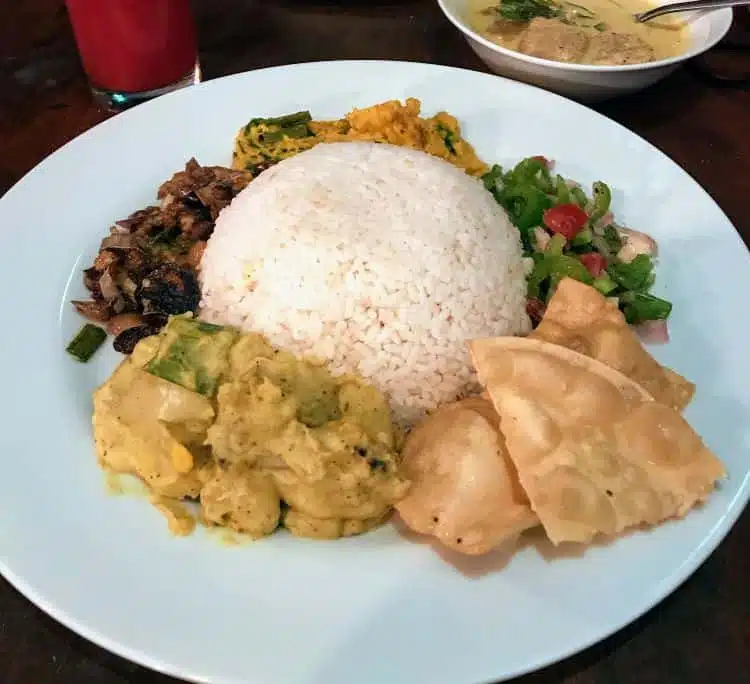
If you ask any local what the one food item is that you must try while visiting Costa Rica, the answer is most probably Casado.
This typical Costa Rican meal offers a variety of ingredients and flavors piled up on one overflowing plate.
Bright colors and enticing smells come standard. Casado is an ideal dish for lunch, traditionally the day’s largest meal.
Different country regions will have variations of the same dish where commonly found ingredients include rice, black beans, cooked vegetables, plantains, and an optional protein entree.
The meat served varies and may include beef, fish, chicken, or pork, depending on the day. Often the Casado includes french fries, pasta salad, or extra vegetables such as avocados or cabbage.
More of a combination platter rather than a specific recipe, Casado effortlessly brings together these items to supply a complete meal for many people without spending a fortune.
Fortunately, as a staple of the country’s food scene, which features an abundance of exotic food, Casado can be found everywhere, at any time of the day.
Make a stop at a soda to experience this dish at its best. A fundamental dish that is now a celebration of local life.
5. Tres Leches
Recommended by Chelsea from Pack More Into Life
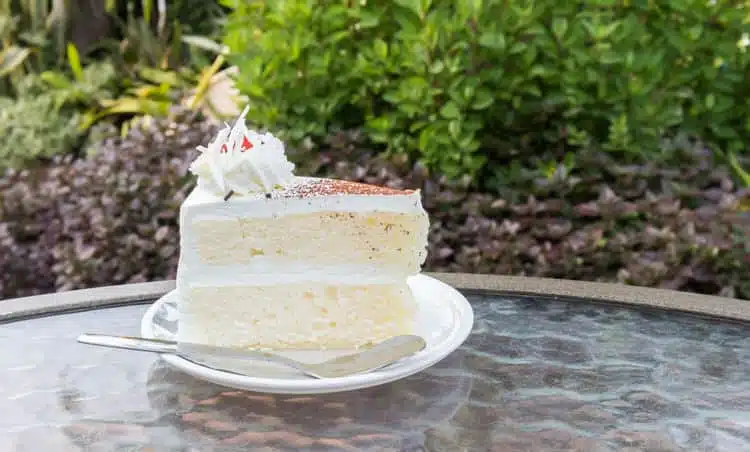
No visit to Costa Rica is complete without a few sweets. One of our favorite desserts is the Tres Leches cake, otherwise known as the “three milks cake.”
It is popular all over Latin America and is a vanilla sponge cake soaked in a sweet cream sauce made up of 3 different types of milk- evaporated milk, condensed milk, and heavy cream.
The cake style is similar to how Tiramisu is made in Italy and rum cake is made in Britain.
The first recipe for Tres Leches cake appeared on the Nestle Condensed milk cans in the 1930s.
There are a few variations depending on which region of Latin America you visit, but the cake base is always moist, sweet, and melts in your mouth.
A bit of whip cream is added on the top with a strawberry or cherry; it is certainly not for anyone with lactose intolerance.
So the next time you are in Costa Rica, be sure to ask the server at your restaurant if they serve Tres Leches, and if they do, be sure to save a bit of space for this delicious dessert.
If your plans include a trip to Manuel Antonio, check out my top recommendations for restaurants in the area, including a few that serve Tres Leches cake.
6. Caribbean Rice and Beans
Recommended by Ayngelina from Bacon is Magic

Although Costa Rica is a comparatively small country, there are plenty of regional Costa Rican dishes that have been influenced by geography and immigration.
Perhaps the most noticeable region is in southern Costa Rica, with strong Caribbean influences, particularly Jamaicans who immigrated to Costa Rica to work on the railroad.
In fact, many of the exotic Costa Rican fruit trees were originally brought to the country by Jamaicans.
And while Gallo pinto is very common in Costa Rica, in the south there, it’s more common to find a dish called Caribbean rice and beans. And while Costa Ricans speak Spanish, it’s called “rice and beans” by everyone.
On the Caribbean slope, in popular cities like Puerto Viejo, rice and beans are white rice and red beans cooked in coconut milk and spicy Panamanian pepper.
This rice is so spicy that a scotch bonnet would be a good substitution if you can’t find this pepper.
You can find this dish throughout the Caribbean; in particular, it’s widespread in Belize and Honduras and is called coconut rice and beans.
In Jamaica, it’s better known as Jamaican rice and peas.
7. Vegan Food in Costa Rica
Recommended by Ashley from Wild Hearted
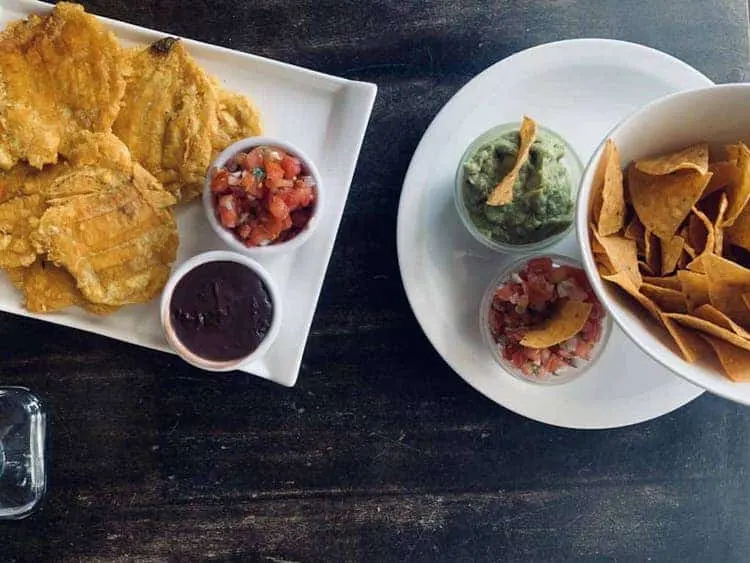
Many amazing traditional Costa Rican dishes will be recommended for you to try.
However, when traveling as someone with special dietary restrictions, you can’t always take everyone’s food advice.
So, how is traveling as a vegan in Costa Rica?
Surprisingly easy!
Unlike some other Latin American countries, much traditional food in Costa Rica is naturally vegan. When eating beans, it is always important to ask what they’re cooked in, as lard is often used.
However, in Costa Rica, it is commonly not used. Asking for many dishes sin Carne (without meat) often immediately makes a dish vegan.
A traditional Costa Rican breakfast is Gallo Pinto, which comprises rice and beans sautéed alongside vegetables and fried plantains. A traditional Costa Rican lunch or dinner dish is Casado, which comprises meat, rice, beans, veggies, and fried plantains.
Every place is more than likely going to have a vegetariano option. While this dish is found at almost every eating establishment, the flavors and seasonings are always different, meaning you’ll never get bored with this dish.
The main thing to remember in Costa Rica as a vegan is that vegan isn’t widely known.
While it will be much more common in places like Playas del Coco and Tamarindo, where restaurants have dishes actually marked vegan, the term itself won’t be as widely known.
This is why having the traditional vegan dishes is so wonderful, as well as knowing just a few Spanish terms such as Carne (meat), Pescado (fish), huevos (eggs), Leche (milk), queso (cheese), miel (honey), and lacteos (dairy).
Just use the term sin before all these to say “without.”
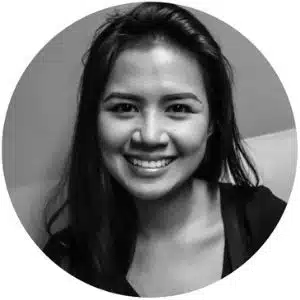



Leave a Reply